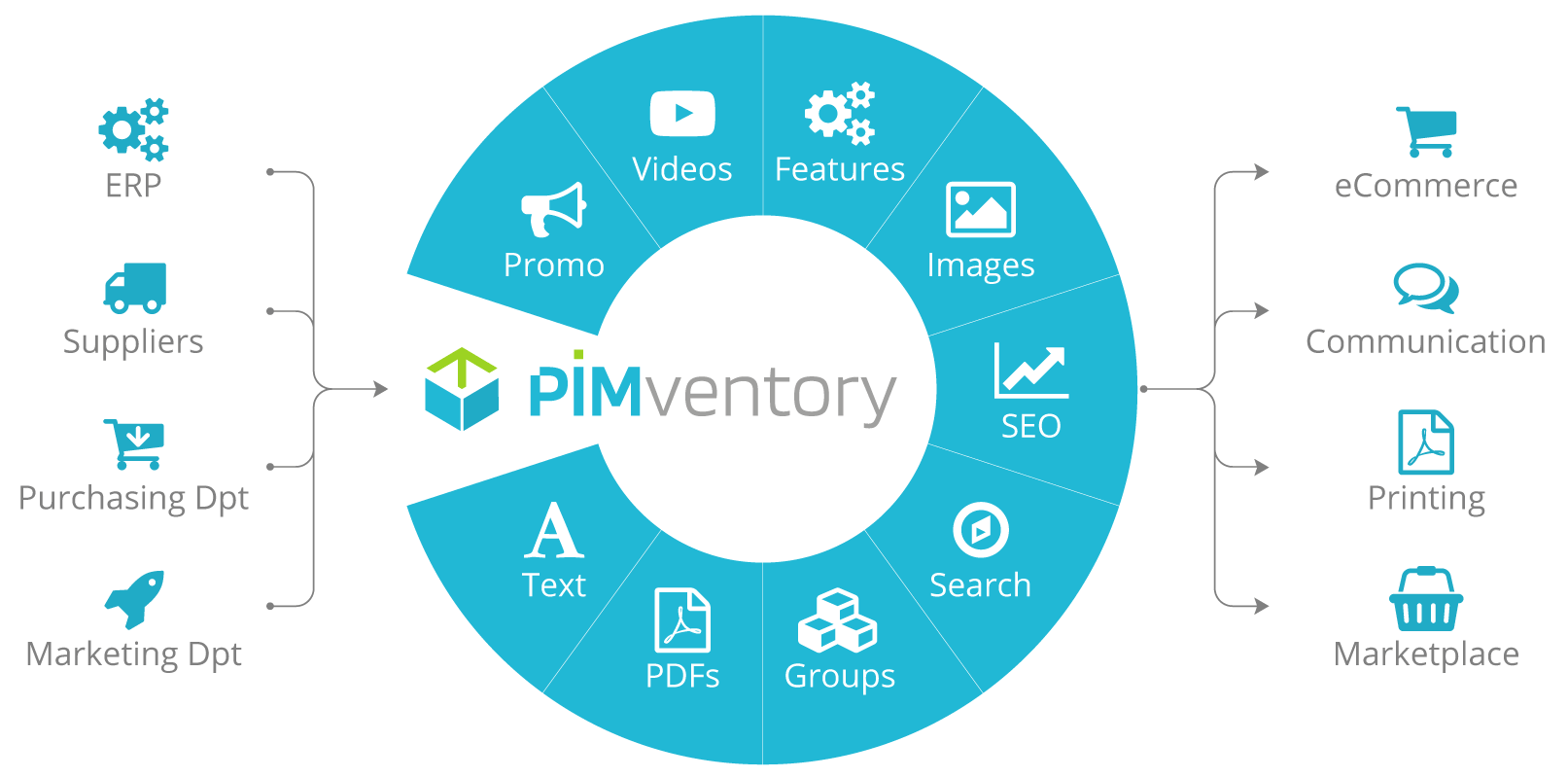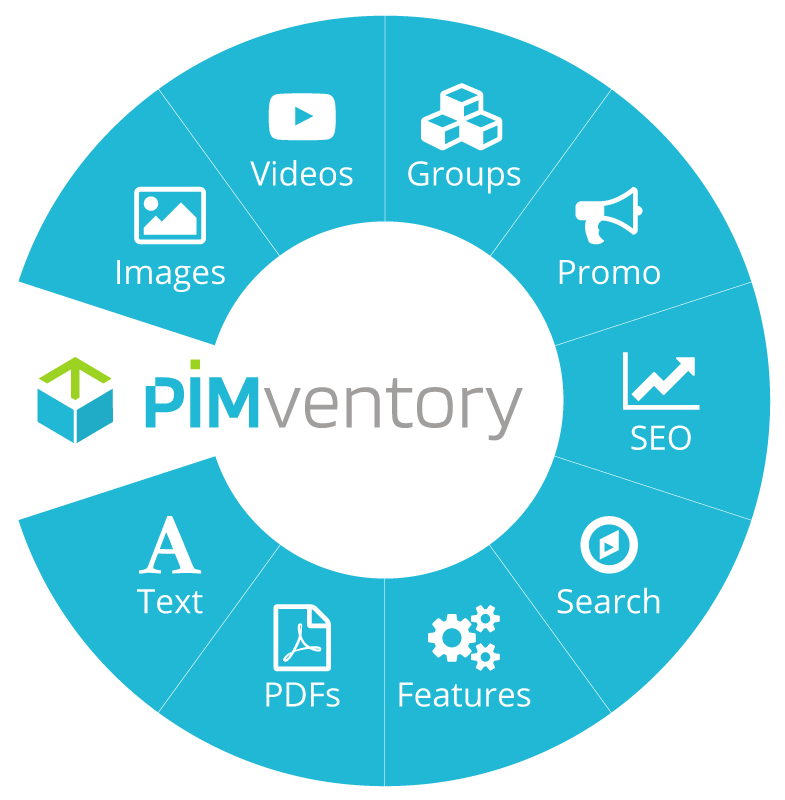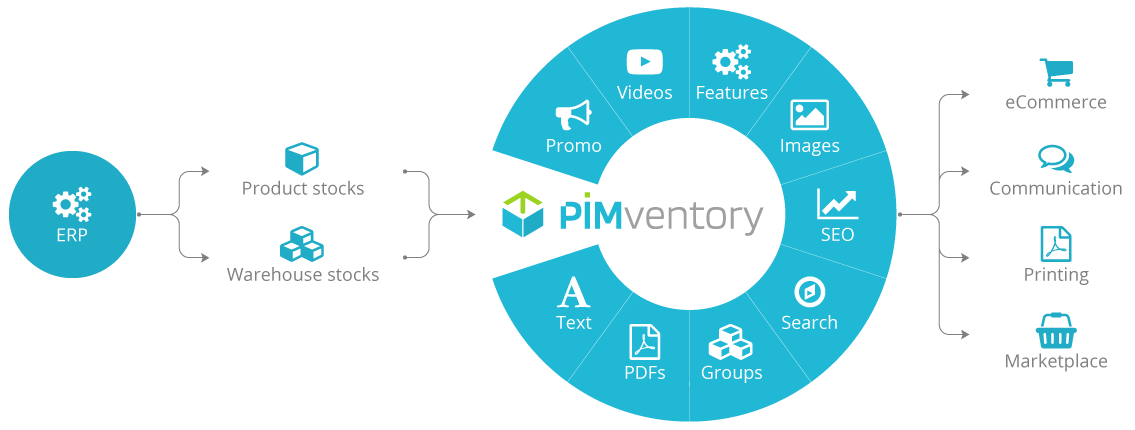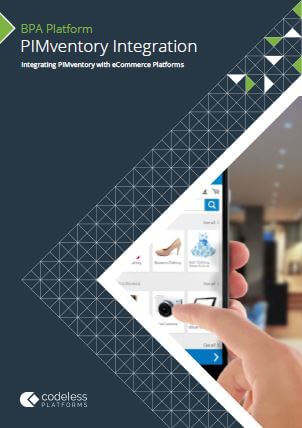PIM integration provides B2C and B2B organisations from retailers, distributors, and manufacturers with a means to reduce repetitive data entry and ensure product catalogue consistency between multiple business systems, applications, sales channels and marketplaces regardless of where the data is primarily stored or changed.
The following article will provide you with a quick start overview on product information management (PIM) and help you learn how integrating a PIM application with your other business systems can provide you with a centralised database of all product information with complete visibility of your product catalogue.
Learn more on how PIM integration provides B2C and B2B organisations with the ability to ensure product catalogue consistency and reduce operational costs to drive company revenue by downloading the brochure below.
What is a PIM?
A PIM is seen by many B2C and B2B organisations as a strategic move within eCommerce merchants and wholesalers as it provides the ability to store and manage product data in one database.
A PIM is a product information management solution that enables you to take full control over product information and electronic catalogues. PIM systems enable businesses to centralise, access and manage all product information from one database source and track the status of product pricing, sales and stock levels.
Product data managed within a PIM application can include all digital assets, such as manufacturer, SKUs, names, titles and descriptions as well as technical specifications such as pricing and discounts, images, videos, documents and marketing material.
One of the key aspects of using a PIM to manage your product catalogue is that it enables both B2C and B2B organisations to improve channel management by providing the ability to take control over sales channels, including mapping quality data to multichannel such as 3PL, Amazon, eBay and eCommerce web stores.

Image: PIM in Business Example
Typical modules that are available within a cloud-based PIM system include:
- Products: Store, create, edit and delete product items from your catalogue
- Digital Asset Management: Manage product information including; Product data such as manufacturer, SKUs, names, titles, descriptions; Technical Specifications: pricing and discounts, dimensions, weight, images, videos etc.; Documents: marketing material, SEO, keywords, personas etc.
- Channel Management: Map product information and data to multichannel e.g. 3PL, Amazon, eBay, eCommerce web store etc.
- Supplier Management: Manage supplier details including contact details, products supplied, order history, onboard new suppliers, enable suppliers to update pricing
- Dashboard: A graphical overview of products including stock quantity, product out of stock, product returns, top selling products, current promotions etc.
A PIM for eCommerce manages your entire product catalogue and enables data to be synchronised from your PIM to sales channels such as your eCommerce store. Common requirements for a PIM for eCommerce applications include:
- PIM for Shopify
- PIM for BigCommerce
- PIM for Magento
- PIM for WooCommerce

Image: PIM System Module Overview.
A dedicated PIM for your eCommerce platform such as the product information management application, PIMventory will help to bring disparate product data together, allowing you to concentrate on getting your products to market quicker and ensure 100% correct product listings.
Download the brochure below to learn how a PIM system can improve product information management tasks and provide you with a centralised database of all product data.
Why do I need a PIM?
Each company will have its own specific needs and PIM requirements. Whether you need a PIM system or not will be apparent when analysing company requirements and the volume of SKUs and product suppliers that you are currently managing and plan to manage in the future.
If you are managing 50-100 SKUs and one product supplier you may not benefit from implementing a PIM solution. If you are managing 15,000 SKUs or more through multiple product suppliers then the benefits of a PIM will be quite apparent. Common ways to identify whether a PIM solution is fit for purpose within your business requirements include:
- Volume of SKUs are eating into valuable resource time in manual administration
- You sell your product in more than one channel e.g. eCommerce web store, Amazon and eBay etc.
- Product information needs to be shared across the business, departments, employees and systems
- You have multiple product suppliers where product data needs to be administered
- You frequently add and remove new or old product lines
PIM Benefits
As products are at the centre of your business, a PIM will not only ensure that product information is correct and consistent, but it will also provide your customers with an improved buying experience. Improved product data with descriptions, images and videos helps with eCommerce and marketplace sales conversions, in return this will decrease product returns as it removes manual administration errors and highlights product mis-categorisation and missing product information.
The benefits of a PIM, with integration, allows product information to be easily fed into an ERP system, eCommerce web site, print catalogue and marketing systems. This provides a centralised base to access and manage PIM data from one database source and track the status of product pricing, sales and stock levels. In turn, this helps you to reduce errors and data duplication, run your business cost effectively and get to market quicker.
The most common commercial PIM benefits include:
- Removal of manually managing product information with Excel spreadsheets
- Product data held in a centralised database to create, edit and delete product catalogues
- Complete visibility of product information across all relevant systems
- Improve digital asset management
- Ability to reach new markets and go to market quicker
- Increased sales conversions and reduced product returns due to improved product listings
- Ability to reach new markets
- Enhanced management and onboarding of suppliers
How much does a PIM cost?
One of the frequently asked questions surrounding PIM implementation is “how much does a PIM cost?” There are a several factors that need to be taken into consideration when selecting the right PIM for your exact business requirements.
In the first instance, the costs of a PIM solution can be determined by the number of SKUs, attributes and media usage, locations, sales channels, number of PIM users and integration requirements.
If you are running 15,000 SKUs in your ERP system and are looking to push these into your eCommerce store and marketplaces such as Amazon and eBay you will need a PIM solution that is capable of holding a large volume of data with the ability to push and pull relevant data between online sales channels and your ERP system.
A complex PIM project that involves intricate bespoke development and configuration, data migration, integration with multiple stores and systems and additional business process automation requirements can all impact the final project cost.
Common areas that are included in PIM costs include:
- Number of SKUs that will be held and managed
- Volume of attributes and media usage will impact the costs of storage required
- Number of users accessing the PIM to create, update and delete product information
- Number of system locations e.g. systems and applications hosted on-premises or in the cloud
- Support for multiple languages
- Business rules and workflow logic needs to be customised e.g. only download fully paid orders
- System integration; is it an API connection or do you need a specialist business process automation and system integration solution such as BPA Platform to integrate multiple databases whether on-premises or cloud-based
PIMventory Cost
- Starts from: £7,500*
- Number of SKUs: 15,000
- Minimum Number of Users: 5
- Storage: 400GB
*Billed annually
Download the brochure below to learn how a PIM system can improve product information management tasks and provide you with a centralised database of all product data.
PIM Vs ERP – What’s the difference?
Both systems have their own unique functions. The difference between PIM and ERP is that a PIM system is purely focused on the management of product information and technical specifications whereas an ERP system focuses on the management of transactional data that drive business processes and workflow.
PIM is a digital asset management solution that is designed for maintaining product information and marketing this data to sales channels such as an eCommerce store, Amazon, eBay or 3PL and is the central point for all product data.
A PIM solution needs to acquire some product information from an ERP system or Excel spreadsheets, FTP and other data sources. Creating a new product line within a PIM means that products can be made available immediately and transferred in to an ERP system automatically in pseudo-real-time if integration is in place.
An ERP system manages related business processes and workflow that sit behind your product catalogue. It manages information from all departments and controls transactional data such as inventory levels and pricing, customer relationships, purchase orders, reporting and accounting information.
Primarily holding product information in an ERP system can mean that the ERP system requires additional development time and resource. When a new product line is created in ERP software, data fields for categories, products, descriptions and images will need to be created to fit into relevant data sets, eating into employee time and delaying time to market.
This is an additional cost that many organisations could live without. In many instances an ERP systems’ functionality can be extended with third-party applications, this can include a PIM system that will be the central point of product information or a customer portal to manage payments or orders. An ERP system receives and processes other related business information for reporting and to aid management decision making.
Data typically held within an ERP system such as SAP Business One, Microsoft Dynamics NAV and Sage 200 includes:
- Inventory e.g. stock levels and pricing
- Order processing e.g. order entry, credit checking, pricing, shipping, sales reporting etc.
- Product manufacturing e.g. bill of materials, work orders, scheduling, quality control etc.
- Accounting e.g. general ledger, fixed assets, accounts receivable, accounts payable, purchase orders, invoices, reporting etc.
- Supply chain management e.g. planning, supplier scheduling, purchasing, warehousing, picking / packing, goods in etc.
- Project management e.g. project costing, work breakdown, billing, time and expense etc.
PIM software saves time when adding new product lines and does not need additional bespoke development like an ERP does. Products that are initially added to a PIM are ready to go to market which allows you to market the product quickly and easily without the development delays that would occur if a new product line was added to your ERP software.
A PIM system should not be a replacement solution for your ERP system, but an extension to enhance your product catalogue and business processes. PIM integration with your ERP system will provide you with an all-round business solution that works the way you do, particularly when you need to manage thousands of SKUs. Integration synchronises relevant data between both systems such as orders and pricing enabling you to reduce bi-directional data entry costs and remove associated errors.
Download the brochure below to learn how a PIM system can improve product information management tasks and provide you with a centralised database of all product data.
What is PIM integration?
Product data is stored in a variety of formats or is held with individual employees and databases. Some organisations hold product data in Excel spreadsheets and some within a system database. Disparate product data can lead to incorrect product descriptions and listings, low stock levels and complex business processes which are prone to error, take time and costly.
PIM integration provides both B2C and B2B organisations with the ability to integrate their product information management system with other business systems and applications such as an eCommerce web store or ERP software to improve the management and consistency of product catalogue information. Individual business systems and applications can hold important product data which can lead to errors due to a complex administration process. Synchronising product information between multiple systems and applications reduces repetitive data entry tasks and improves the structure of product information data. Common PIM eCommerce integration requests include:
- PIM Shopify integration
- PIM Bigcommerce integration
- PIM Magento integration
- PIM WooCommerce integration
In many instances, an organisation may hold inventory information within its ERP system. This is a common practice undertaken by many businesses as an ERP solution can often be the central point for business information. An ERP system allows you to control inventory, customer relationships, accounting, pricing, purchase orders and at its most basic standing integrates all of these functions into one centralised system.
However, solely holding product information within an ERP system can lead to challenges further down the line. An ERP system, in most instances will require bespoke development time to make new categories, products, descriptions and images fit into relevant data fields. A Product information management system is not limited to pre-defined data fields, allowing flexibility, saving development times and reducing operational costs.

Image: PIM Integration Example
An integration between a PIM system and ERP software can increase the consistency and visibility of information across the business. PIM integration means that stock levels can be automatically synchronised in pseudo-real-time when an order depletes inventory levels to ensure up-to-date 100% of the time. It will also synchronise product information across multiple eCommerce stores and marketplaces reducing repetitive, bi-directional data entry and allowing you to go to market quicker to drive company revenue.
PIM integration can be achieved through the use of an API to push product data to your eCommerce platform and marketplaces. Advanced integration into an ERP system or to include business logic and workflow may require the use of the business process automation solution, BPA Platform.
BPA Platform provides an iPaaS solution that supports cloud, hybrid and on-premises environments and will enable you to automate extended business processes such as database monitoring, alerts and notifications, workflow approvals and report automation. The diagram below details how BPA Platform sits at the core of an organisations business processes.
Learn more about PIM Integration
PIM Integration Benefits
Adding integration to your product information management processes will help you to enhance company performance. It will reduce the repetitive data entry tasks that surround your product catalogue, enabling employees to concentrate on value added tasks such as building relationships with suppliers and additional sales and marketing activities. The common commercial benefits that surround PIM integration include:
- Simplify product information management processes
- Reduce repetitive bi-directional data entry tasks
- 100% accurate product data and inventory levels regardless of business system or application
- Ability to go to market quicker and expand sales channels
- Complete visibility of product catalogue to aid decision making
- Reduced operational costs
Learn more on how PIM integration provides B2C and B2B organisations with the ability to ensure product catalogue consistency and reduce operational costs to drive company revenue by downloading the brochure below.
PIM Integration Next Steps
Codeless Platforms’ PIMventory application is suitable for retailers, distributors, and manufacturers to quickly and easily improve the management and visibility of product information. It has a proven track record in providing business process automation and system integration solutions that help organisations get the most out of business data, reduce administration times and costs and improve company revenue. For more information on how PIM can help you to improve company performance download the brochure below or call us on +44 (0)330 99 88 700.

